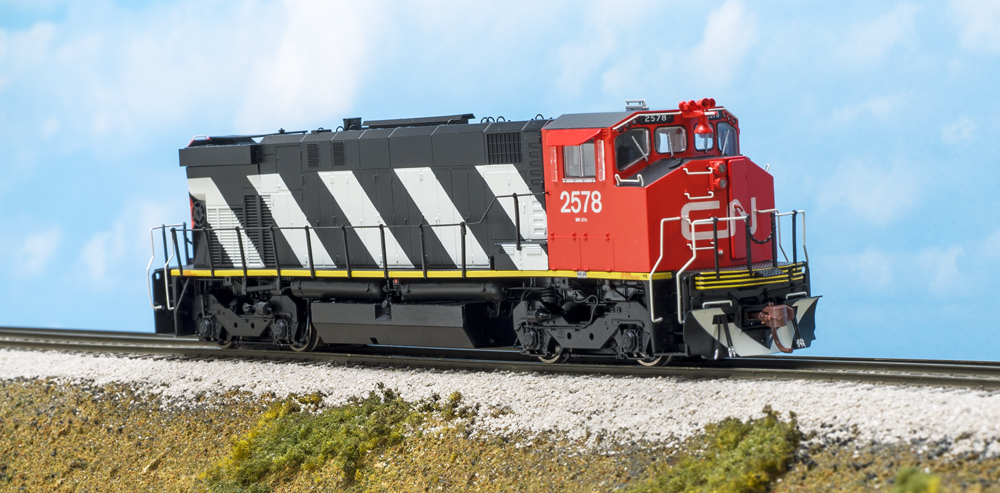
Rapido Trains is bringing the comfort, Canadian style. We recently received a sample of the company’s new Montreal Locomotive Works (MLW) M420 loco- motive, and it’s a beauty, eh?
The prototype. When Alco locomotive production ceased in Schenectady, N.Y., in 1969, locomotives continued to be built in Canada by former subsidiary Montreal Locomotive Works until 1985. While MLW never offered its own ver- sion of the Century-series C-420, it did develop a 420 for its “M” line of Montreal-designed power.
The M420 used a 2,000-horsepower 12-cylinder 251 series diesel engine and AC traction. It also introduced the wide- nose Canadian cab (also known as the comfort or safety cab) to North American rails. One of the main features of this cab was a reinforced nose section to protect the crew in the event of a collision.
The model. Our sample from Rapido is painted in the CN zebra-stripe scheme and captures the look of the prototype well. As usual, there are hundreds of detail parts on the shell and underframe. There’s also a detailed interior and a new feature – a replaceable nose door.
After carefully releasing the closed door from the model with the tip of a hobby knife, I installed an open door in its place. I had to scrape paint from the pins that hold the door in place so it would fit the holes molded in the body. If you enlarge the holes in the body, the closed door won’t stay in place.
A feature I really appreciate is Rapido’s wire and plastic handrails. The plastic stanchions are well detailed, and the wire railings are sturdy and scale sized.
The model measured within scale inches of drawings in the Car and Locomotive Cyclopedia Centennial Edition (1974) from Simmons-Boardman. All of the paint was opaque and smoothly applied with sharp color separations. Lettering was likewise sharp, opaque, and legible down to the smallest type.
Because of all the detail parts on the model, I didn’t try to remove the shell. An exploded-view drawing shows the model has a center-mounted motor with flywheels. The motor is concealed in a horizontally split die-cast metal frame. A motherboard is screwed to the top half of the frame, and an ESU LokSound V5 decoder plugs into that. A pair of downward-facing sugar cube speakers are in an enclosure mounted just ahead of the rear truck.
On the test track. I tested the locomotive on the MR staff’s Milwaukee, Racine & Troy layout. The Rapido M420 put its 1-pound, 2.4-ounce weight to use, pull- ing 15 cars up the 3 percent grade. The burble of an Alco 251C is always popular, and the LokSound version sounds as good as expected.
Back in the workshop I measured a barely perceptible .5 scale mph speed at speed step 1 using our NCE PowerCab DCC system. Top speed was 61 scale mph, just a little below the prototype’s 65 mph top speed.
Using direct-current from an Atlas train set power pack, it took 8.5V for the sound package to start up. At 10V, the locomotive started to move at .7 scale mph, and hit 31 scale mph at 12V. The power pack’s maximum voltage, 14V, produced 80 scale mph.
This is another well-detailed model from Rapido. The innovative handrails appear to be the company’s new standard. The optional open door adds another feature that boosts realism without being a gimmick. Canadian National modelers hit the jackpot with this one.
Facts & features
Price: $335 (DCC, sound), $225 (DC, no sound)
Manufacturer
Rapido Trains Inc.
500 Alden Rd, Unit 21 Markham, ON
L3R5H5 Canada
rapidotrains.com
Era: 1973-1997
Road names: Canadian National stripes (8 numbers), CN red-orange cab and stripes (2 numbers)
Features
– Detailed cab interior with optional open front door
– Die-cast metal chassis
– Macdonald-Cartier knuckle couplers mounted at the correct height
– Metal handrails with plastic stanchions
– Operating headlights, rear lights, tri-color class lights, and illuminated cab control stand
– Weight: 1 pound, 2.4 ounces













